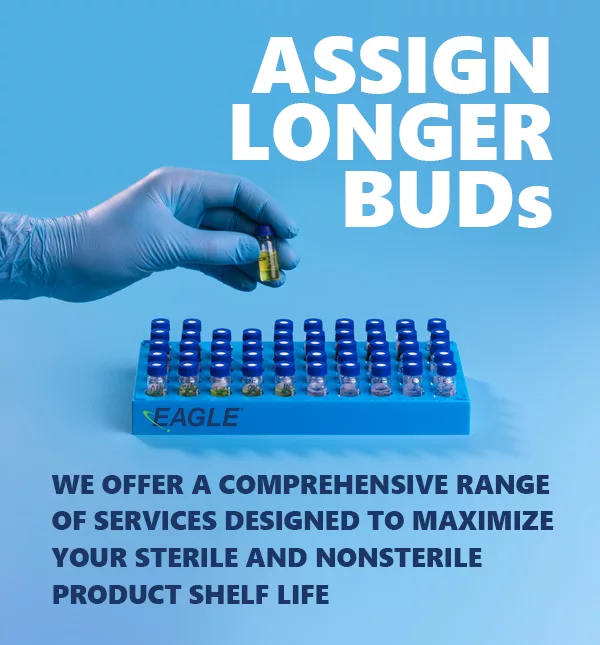Beyond-Use Dating
A beyond-use date, also known as BUD, is the date, or hour and date, beyond which a compounded preparation, sterile or nonsterile, cannot be used and should be set based on the date or date and time of compounding.

Establishing BUDs for Compounded Nonsterile Preparations (CNSPs)
Table 1 defines the maximum BUDs for compounded nonsterile preparations packaged in tight, light-resistant containers as specified in USP <795> Pharmaceutical Compounding – Nonsterile Preparations. BUDs have been set based on the CNSPs ability to maintain chemical and physical stability, limit microbial proliferation, and established by the type of preparation, dosage form, and associated water activity (aw) of the final formulation.
Water activity testing can be performed by Eagle to help your facility support the established BUDs of your formulation. Contact a member of Client Care to learn more.
BUDs can be extended for CNSPs up to a maximum of 180 days when supported by stability studies performed utilizing a validated, stability-indicating method. Stability studies must be performed for the exact formulation and in its final container-closure system. Additionally, USP <51> Antimicrobial Effectiveness Testing (AET) must be performed for preserved, aqueous dosage forms. Nonpreserved aqueous dosage forms shall not extend beyond the limits and storage temperatures established in Table 1.

Establishing BUDs for Compounded Sterile Preparations (CSPs)
The revisions to USP <797> Pharmaceutical Compounding – Sterile Preparations published on November 1, 2022, eliminated the low, medium, and high-risk compounding categories and have introduced Categories 1-3, which, along with method of sterilization and performance and passing of sterility testing, are the basis of establishing BUDs for compounded sterile preparations (CSPs).
Table 2 defines the maximum BUDs for compounded sterile preparations (CSPs) packaged in containers that can maintain their integrity throughout the duration of the established BUD.
Water activity testing can be performed by Eagle to help your facility support the established BUDs of your formulation. Contact a member of Client Care to learn more.
BUDs can be extended for CNSPs up to a maximum of 180 days when supported by stability studies performed utilizing a validated, stability-indicating method. Stability studies must be performed for the exact formulation and in its final container-closure system. Additionally, USP <51> Antimicrobial Effectiveness Testing (AET) must be performed for preserved, aqueous dosage forms. Nonpreserved aqueous dosage forms shall not extend beyond the limits and storage temperatures established in Table 1.
The BUDs in Table 1 and Table 2 are the limits for compounded preparations in the absence of formulation-specific stability information. It is the compounder’s responsibility to ensure that the established BUDs are appropriate to maintain the formulation’s physicochemical stability. Furthermore, BUDs should not exceed the expiration date of any individual ingredient in the formulation, excluding pH-altering solutions.
To learn more about performing stability studies for extending CNSPs or Category 3 CSPs contact a Client Care team member today.

Do Not Let Your Products Go To Waste
Experience the difference our services can make for your facility. Complete form to get your free initial beyond-use date consultation.
Let Our Experience Work For You
Cutting-Edge Our Laboratories
Eagle’s cutting-edge 80,000-square-foot facility and laboratory are equipped with advanced technologies and specialized segregated laboratory spaces to meet the diverse needs of our clients. This behind-the-scenes video provides you with an opportunity to witness testing while touring our laboratory.
